 Download PDF
Download PDF
Name: Rosa multiflora Thunb.
Family: Rosaceae, the Rose Family
Common Names: Multiflora rose (13), Japanese rose (1), rambler rose (18), baby rose (2).
Etymology: The name “Rosa multiflora” is a combination of Latin words: rosa; meaning “rose”, multi; meaning “multiple”, and flora; meaning “flower”: A “rose with many flowers” (4).
Botanical synonyms: Rosa cathayensis (Rehder & E.H. Wilson) L.H.Bailey, and Rosa watsoniana Crép. (13)
Quick Notable Features (1):
¬ Styles are united to form a column-like structure, extending beyond the styles of similar species.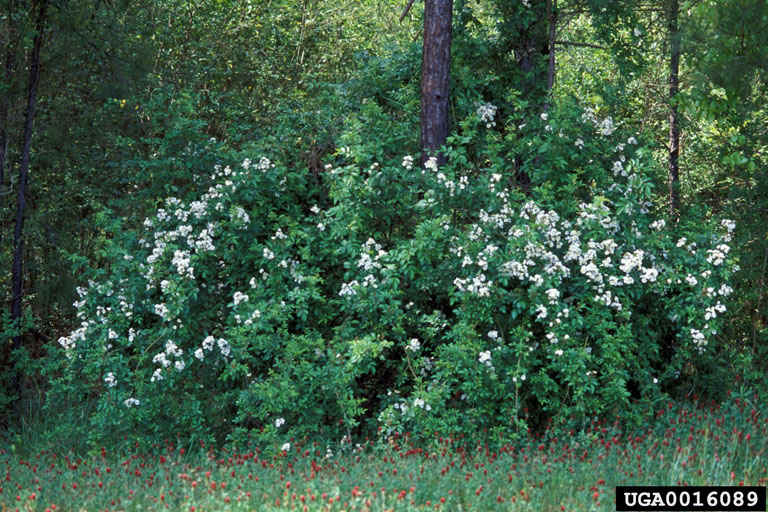
¬ Many white flowers grouped together
¬ In fall, bearing small, glabrous, red fruits: the rose hip.
¬ Stipules notably pectinate or fringed.
Plant Height: 4.5 – 6.5 m (5,10)
Subspecies/varieties recognized (2,19):
R. multiflora var. adenochaeta (Koidz.) Ohwi ex H.Ohba,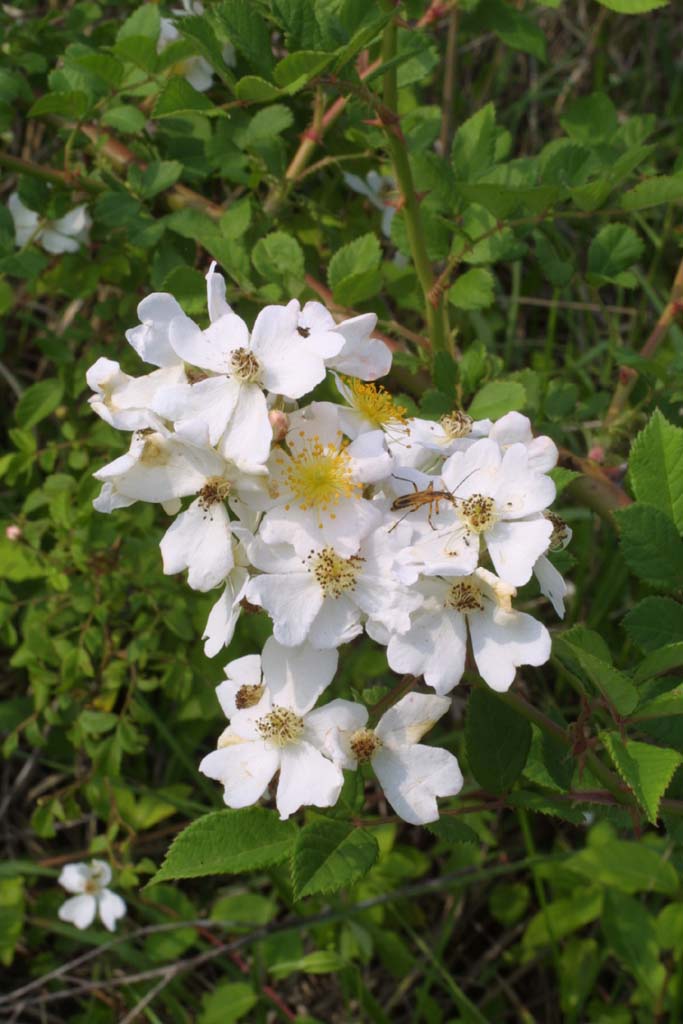 R. multiflora var. albo-plena T.T.Yu & T.C.Ku,
R. multiflora var. albo-plena T.T.Yu & T.C.Ku,
R. multiflora var. nanningensis Y.Wan & Z.R.Huang,
R. multiflora var. taoyuanensis Z.M.Wu
R. multiflora var. brachyacantha (Focke) Rehder & E.H. Wilson
R. multiflora var. calva Franch. & Sav.
R. multiflora var. carnea Thory
R. multiflora var. cathayensis Rehder & E.H. Wilson
R. multiflora var. formosana Cardot
R. multiflora var. gentiliana (H. Lév. & Vaniot) T.T. Yu & H.T. Tsai
R. multiflora var. mokanensis Rehder
R. multiflora var. platyphylla Thory
R. multiflora var. praegeri Dingler
R. multiflora var. villosula F.P. Metcalf
Most Likely Confused with: Rosa setigera and other native roses, various Rubus species (blackberry, dewberry, raspberry).
Habitat Preference: R. multiflora occurs in “roadsides, disturbed woods and borders, fencerows and fields, thickets, and untended yards; sometimes in low ground although usually in dry places” (1).
Geographic Distribution in Michigan: R. multiflora is found most abundantly in the southern half of the Lower Peninsula and is also found in some counties in the northern half of the Lower Peninsula. It is also found in two counties in the Upper Peninsula (16).
Known Elevational Distribution: The multiflora rose can be found from 0 to 1600m above sea level in Cartago, Costa Rica (2).
Complete Geographic Distribution: Native to Japan (2), R. multiflora is found throughout most parts of the world. It can be problematic in its abundance in temperate areas, such as eastern Asia, North America, and Europe (9). In the U.S., it is found in nearly every state east of NM (except ND, SD), and on the west coast. In Canada, it is found in BC, NB, NS, ON, and QC (13).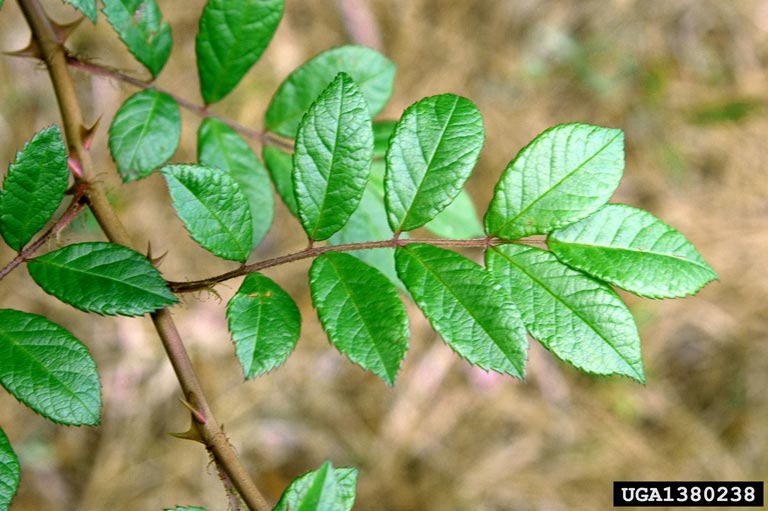
Vegetative Plant Description: Rosa multiflora is a many-branched upright shrub or scrambling climber with arching hairless branches up to six meters tall that turn from green to brown when older (3,6,10,15). The root crown can have a diameter of up to 20cm (12),while individual branches are usually less than 2cm in diameter. Leaves are pinnately compound, with 7-9 leaflets, each of which are 1-6cm in long and 0.8-3cm broad. Leaflets are glabrous above, pubescent beneath, and elliptic – obovate shaped, with finely toothed margins. The leaflet bases are usually rounded or obtuse (3,5,6,7,10). The prickles are “subnodal conical-recurved. The larger prickles, often with a notably longitudinally spreading base (6). The rachises are “pubescent with fine eglandular trichomes, or short stout, glandular trichomes, or both” (3). Stipules are distinctly fringed, glandular, and pubescent. Notably, they are fused to the petiole for up to 75% of their length (3,6,10).
Climbing Mechanism: Climbs as a scrambler supported only by its stems hooking adjacent plants with prickles and spines (R. J. Burnham, pers. obs.).
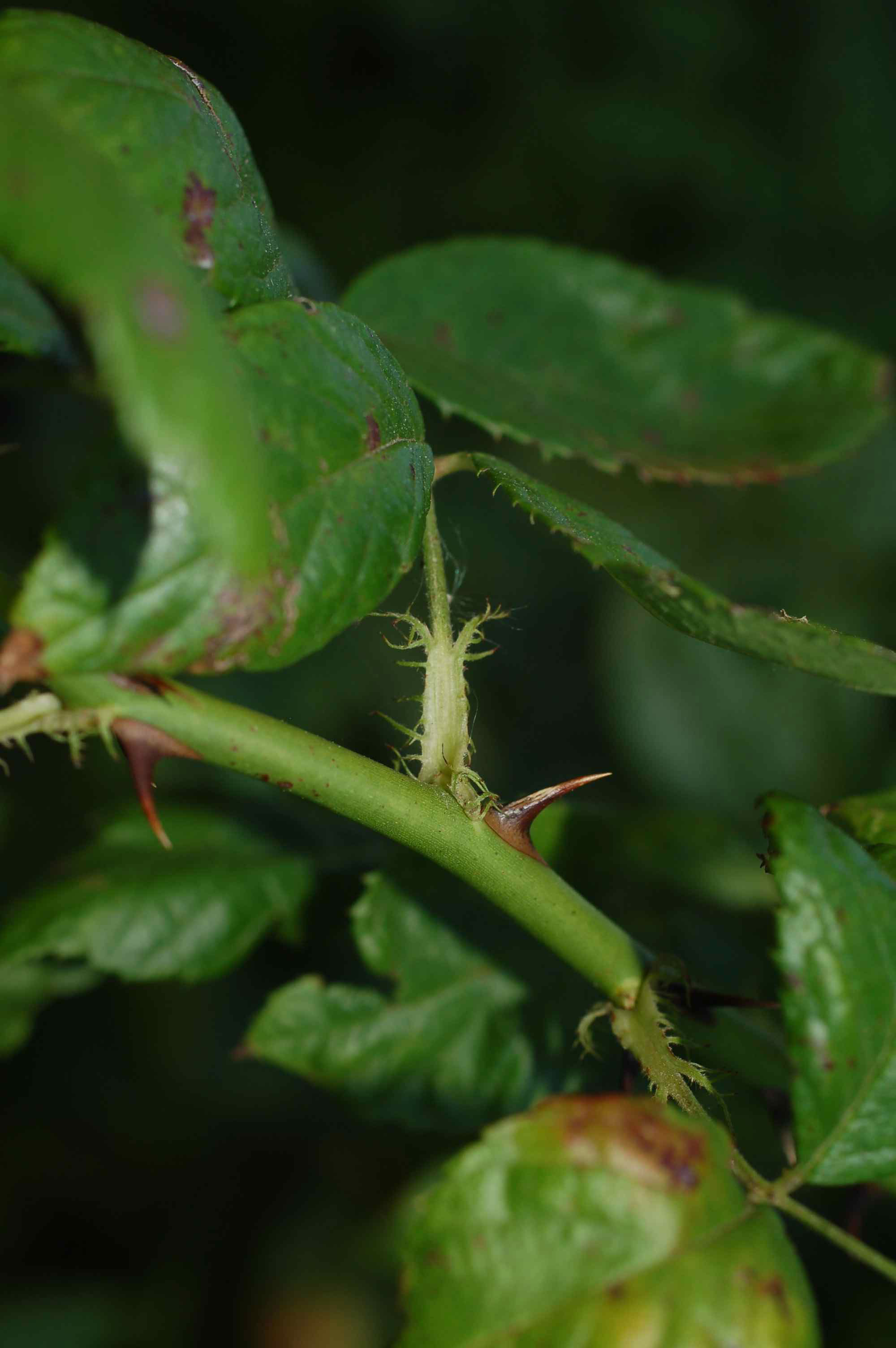
Flower Description: The inflorescence is a many-flowered “bracteate raceme-like corymb or panicle“ (3), each perfect flower 1.9-4cm broad, subtended by deciduous bracts (3,7,12). The five sepals (4-7mm long) are glabrous to cottony pubescent on
the outside and thickly pubescent on the inside (3), and ovate-attenuate or triangular attenuate in shape with at least one long subulate lobulate-enation on a side (6). The five petals are most commonly white or occasionally pale pink, 1.5-2 cm long, broadly obovate, and equally or unequally notched at the apex (6). Numerous stamens are present (10). Pistils are united and form a column–like structure with the styles protruding 2mm from the hypanthium (3). The hypanthium is glabrous to lightly pubescent. As in most Rosa species, the flowers do not produce nectar (15).
Flowering Time: In Michigan, R. multiflora flowers from May to June (3,10).
Pollinator: “The abundant and showy pollen of the flowers attracts various long-tongued bees, including honey bees, bumblebees, miner bees, and Anthophorid bees. These insects are the primary pollinators. The pollen also attracts short-tongued Halictid bees, Syrphid flies, bee flies, and beetles”(15).
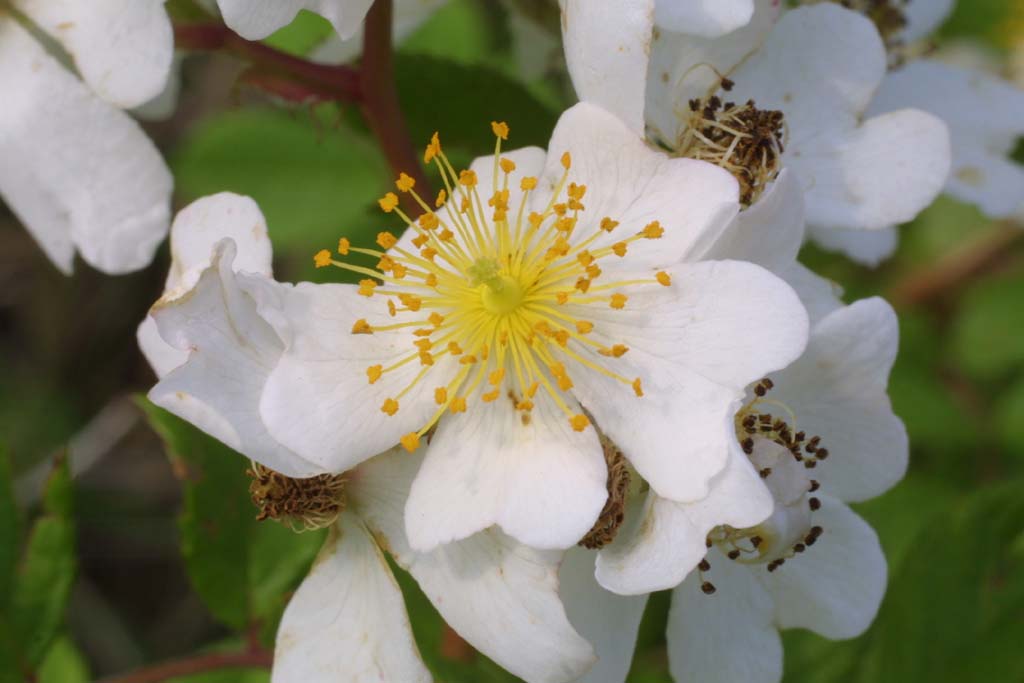
Fruit Type and Description: The fruit is a round aggregate of achenes, known as a “rose hip”. They are fleshy, subglobose, 0.6-0.9cm across, orange or red at maturity, with many enclosed achenes. The fruits may remain attached to the plant during the winter (3,6,7,12,15).
Seed Description: Indivudual achenes containing a single seed are light brown, irregularly angular-obovoid, pubescent, and 2.5-5mm long (3,6,10). Seeds deposited in the seedbank have a longevity of up to 20 years (12).
Dispersal Syndrome: The majority of the seeds contained within the hips of R. multiflora are dispersed near and around the parent plant when the mature fruits fall. The seeds are also dispersed by birds and mammals that consume the fruits. R. multiflora reproduces vegetatively by stem layering (12).
Distinguished by: R. multiflora is distinguished from Rosa setigera by having 5-9 leaflets per leaf where R. setigera generally bears 3, and occasionally 5, leaflets per leaf. The flowers of R. multiflora are predominately white, whereas the flowers of R. setigera are predominately pink. Other native roses can be easily distinguished by the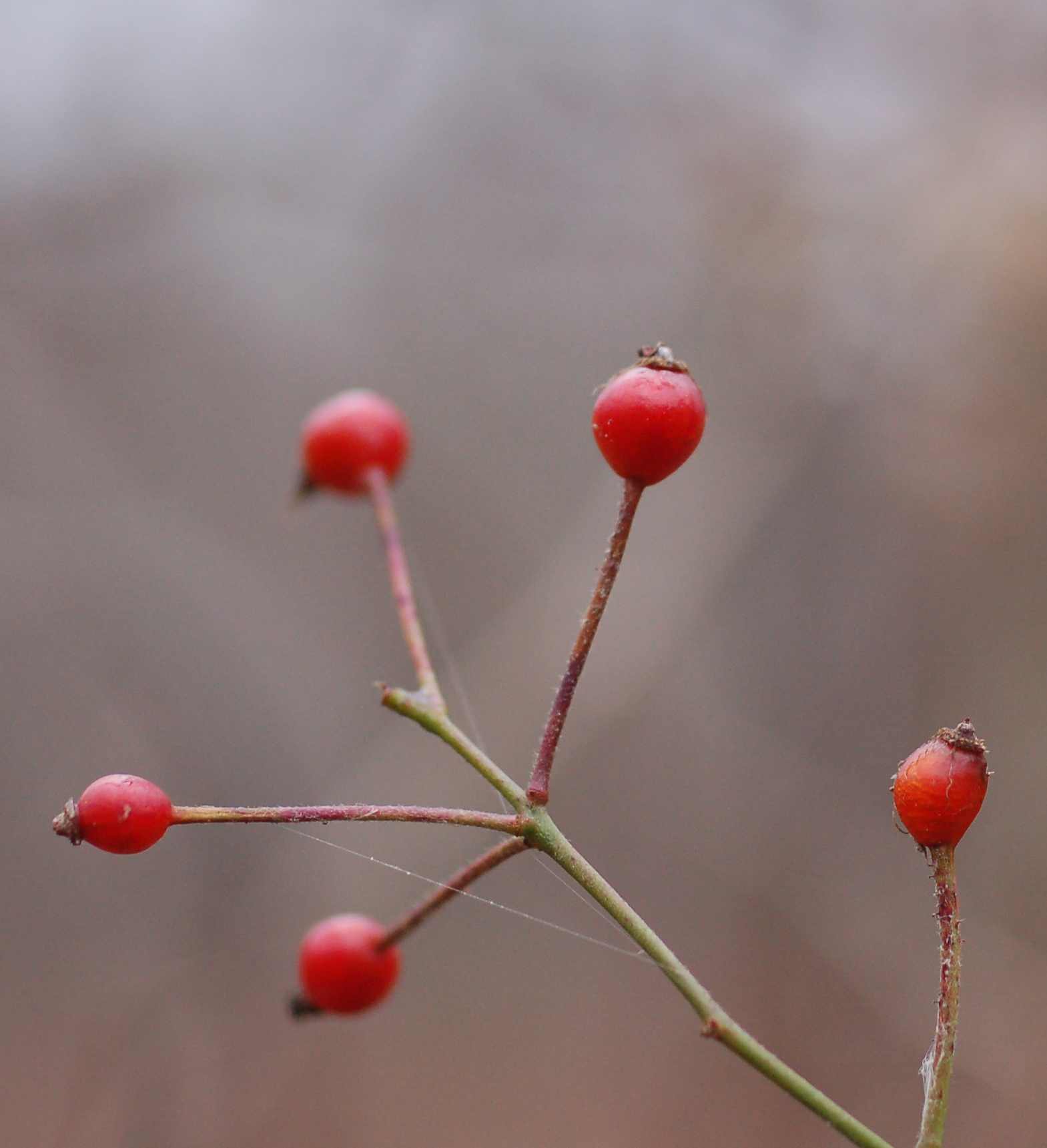 smooth stipule margins (also true in R. setigera), usually larger, pink flowers, and free styles. R. multiflora can be distinguished from members of the genus Rubus by the rose hips which are smooth and round unlike the fruit of Rubus species which are composed of many small, round, fleshy segments, an aggregate of drupelets. R. multiflora is further distinguished from members of the genus Rubus by having seven to nine leaflets per leaf arranged pinnately, whereas Rubus species generally only have three to five (1,12,15,17). Finally Rosa multiflora bears stipules that are adnate to the petiole, whereas the stipules of Rubus are free from the petiole.
smooth stipule margins (also true in R. setigera), usually larger, pink flowers, and free styles. R. multiflora can be distinguished from members of the genus Rubus by the rose hips which are smooth and round unlike the fruit of Rubus species which are composed of many small, round, fleshy segments, an aggregate of drupelets. R. multiflora is further distinguished from members of the genus Rubus by having seven to nine leaflets per leaf arranged pinnately, whereas Rubus species generally only have three to five (1,12,15,17). Finally Rosa multiflora bears stipules that are adnate to the petiole, whereas the stipules of Rubus are free from the petiole.
Other members of the family in Michigan (number species): Rubus (49), Agrimony (5), Amelanchier (6), Argentina (1), Aruncus (1), Chamaerhodos (1), Comarum (1), Crataegus (42), Dalibarda (1), Dasiphorda (1), Duchesnea (1), Filipendula (1), Fragaria (2), Geum (9), Gillenia (2), Malus (4), Photinia (2), Physocarpus (2), Potentilla (11), Prunus (16), Pyrus (1), Rosa (17), Sanguisorba (3), Sibbaldiopsis (1), Sorbaria (1), Sorbus (3), Spiraea (6), Waldsteinia (1) (Source 16).
Ethnobotanical Uses: R. multiflora was formerly planted as a living fence or to protect soil from erosion. Unfortunately the plant readily escapes and becomes weedy (10,12). The hips, young stems and leaves, and seeds (after removing hairs) are edible; the hips are rich in vitamins and essential fatty acids. The leaves can be made into a poultice for open sores. The fruit has pain relieving properties, can help to lower blood sugar levels, is diuretic and laxative (as are the seeds), and can be applied to wounds. The roots offer gas relief and are a potent astringent, rich in tannins (11).
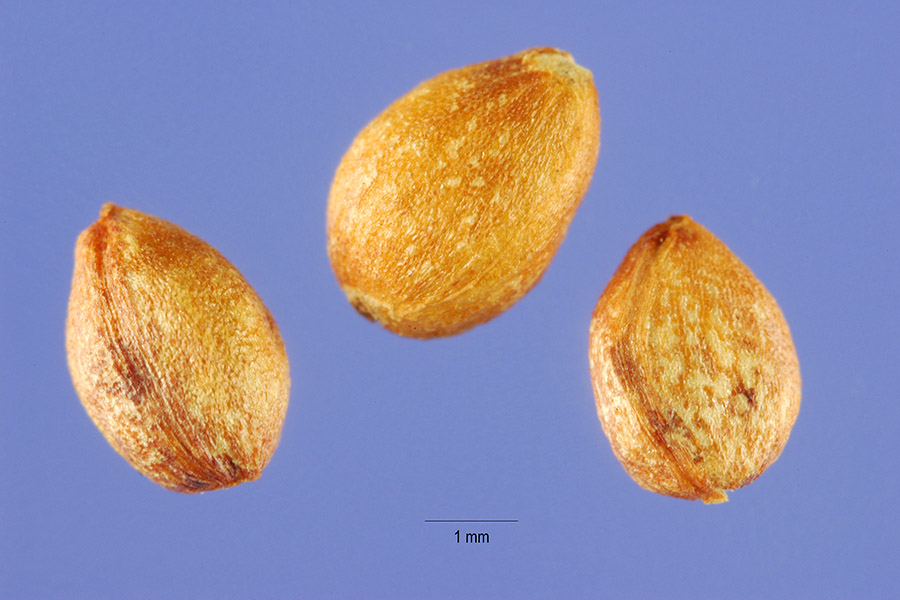
Phylogenetic Information: Rosaceae members are found in almost every inhabitable part of the world. Within this large family, Rosa is in the subfamily Rosoideae. Rosaceae belongs in the order Rosales, and is closely related to Ulmaceae, the elm family. Rosales are classified as members of the Eurosids I subclade in the Rosid clade. Rosids are core eudicots (14).
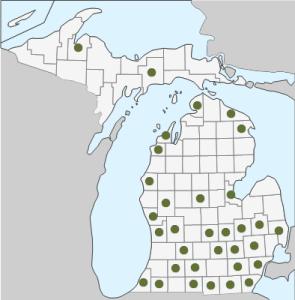 Interesting Quotation or Other Interesting Factoid not inserted above: Since its introduction to the United States in 1886, R. multiflora was planted in places prone to erosion in order to control it, however R. multiflora started spreading across fields creating another problem, and it is now considered an invasive species. R. multiflora can only be controlled effectively by repeated fire and/or mowing treatments (3-6 mowing treatments per growing season), or by cut-stump treatments using poisonous herbicides (10-20% solution of Glyphosate or 50% solution of Triclopyr), which should only be used according to label directions, if at all. If the plant is simply cut and the roots are not completely removed, it will likely re-sprout (12). “R. multiflora currently infests 45 million acres in the eastern United States” (20).
Interesting Quotation or Other Interesting Factoid not inserted above: Since its introduction to the United States in 1886, R. multiflora was planted in places prone to erosion in order to control it, however R. multiflora started spreading across fields creating another problem, and it is now considered an invasive species. R. multiflora can only be controlled effectively by repeated fire and/or mowing treatments (3-6 mowing treatments per growing season), or by cut-stump treatments using poisonous herbicides (10-20% solution of Glyphosate or 50% solution of Triclopyr), which should only be used according to label directions, if at all. If the plant is simply cut and the roots are not completely removed, it will likely re-sprout (12). “R. multiflora currently infests 45 million acres in the eastern United States” (20).
Literature and websites used:
- Voss, E.G. 1985. Michigan Flora Part II: Dicots. Ann Arbor, MI: Cranbrook Institute of Science.
- Tropicos.org. Missouri Botanical Garden. 04 Dec 2013 <http://www.tropicos.org/Name/27801148>
- Radford, A.E., H.E. Ahles, & C.R. Bell 1968. Manual of the Vascular Flora of the Carolinas. Chapel Hill, NC: The University of North Carolina Press.
- Plants For a Future, 1997-2000. http://www.ibiblio.org/pfaf/cgi-bin/arr_html?Rosa+multiflora&CAN=LATIND
- Wood, A.M. 1854. Class-Book of Botany. Claremont, NH: Manufacturing Company.
- Godfrey, R.K. 1988. Trees, Shrubs, and Woody Vines of Northern Florida and Adjacent Georgia and Alabama. Athens, GA: The University of Georgia Press.
- Fernald, M.L. 1950. Gray’s Manual of Botany, 8th ed. New York: American Book Co.
- Armine J.W. 2002. Invasive Plants of the Eastern U.S., Last modified: November 5, 2003. http://www.invasive.org/eastern/biocontrol/22MultifloraRose.html
- Zomlefer, W.B. 1994. Guide to Flowering Plant Families. Chapel Hill, NC: The University of North Carolina Press.
- McGregor, R.L. 1986. Flora of the Great Plains. Lawrence, KS: The University Press of Kansas.
- Plants For A Future, 1996-2012. Accessed: 04 December 2013. http://pfaf.org/user/Plant.aspx?LatinName=Rosa+multiflora
- Missouri Department of Conservation 2013. Multiflora Rose. Conservation Commission of Missouri http://mdc.mo.gov/node/6526
- The PLANTS Database: USDA, NRCS, 1991-2007. http://plants.usda.gov/java/profile?symbol=ROMU
- Stevens, P.F. Angiosperm Phylogeny Website. Version 7, May 2006. http://www.mobot.org/MOBOT/research/APweb
- Weedy Wildflowers of Illinois: Multiflora Rose. 2003-2013. http://www.illinoiswildflowers.info/weeds/plants/multiflora_rose.htm
- Michigan Flora Online. A.A. Reznicek, E.G. Voss, & B.S. Walters. February 2011. University of Michigan. Web. December 4, 2013. http://michiganflora.net/species.aspx?id=2543.
- Ohio Perennial and Biennial Weed Guide. http://www.oardc.ohio-state.edu/weedguide/singlerecord.asp?id=340
- The Nature Conservancy, 2000. Last modified: 2005. http://tncweeds.ucdavis.edu/esadocs/rosamult.html
- The International Plant Names Index (2004). Published on the Internet http://www.ipni.org [accessed 29 November 2007]
- Jesse, L.C., K.A. Moloney, and & J.J. Obrycki 2006. Abundance of arthropods on the branch tips of the invasive plant, Rosa multiflora (Rosaceae). Weed Biology and Management 6:204-211.
IMAGE CREDITS (all used with permission):
1. Image of whole plant courtesy of James H. Miller, USDA Forest Service, Bugwood.org http://www.invasive.org/browse/detail.cfm?imgnum=0016089
2. Image of inflorescence © Steve Baskauf http://bioimages.vanderbilt.edu/baskauf/23663.htm
3. Image of leaf courtesy of Chris Evans, Illinois Wildlife Action Plan, Bugwood.org http://www.invasive.org/browse/detail.cfm?imgnum=1380238
4. Image of stipule and prickle © Robyn J. Burnham, University of Michigan, Ann Arbor, MI USA.
5. Image of close-up flower © Steve Baskauf http://bioimages.vanderbilt.edu/baskauf/23671.htm
6. Image of fruit © Robyn J. Burnham, University of Michigan, Ann Arbor, MI USA.
7. Image of seeds courtesy of Steve Hurst @ USDA-NRCS PLANTS Database http://plants.usda.gov/java/largeImage?imageID=romu_002_ahp.tif
8. Species distribution map, derived from the Michigan Flora Online.
Primary Author: Geordan Hudson with edits and additions from John Bradtke, Robyn Burnham, & Cristine V. Santanna.
© Robyn J. Burnham, University of Michigan
For additional information on Michigan Plant Diversity web pages please contact Robyn J. Burnham via email: rburnham“at”umich.edu